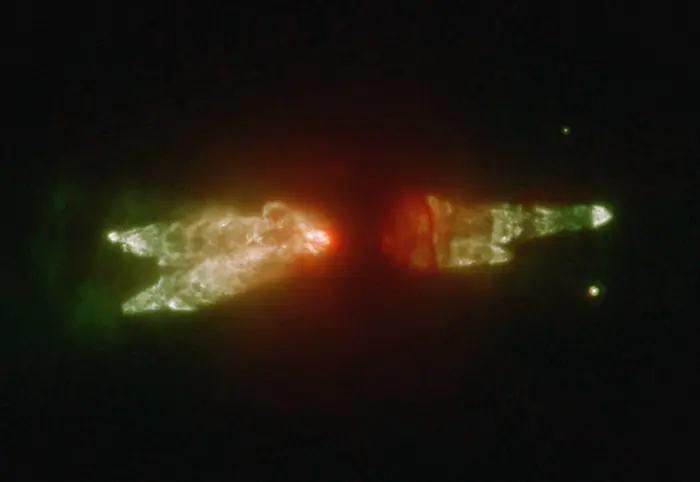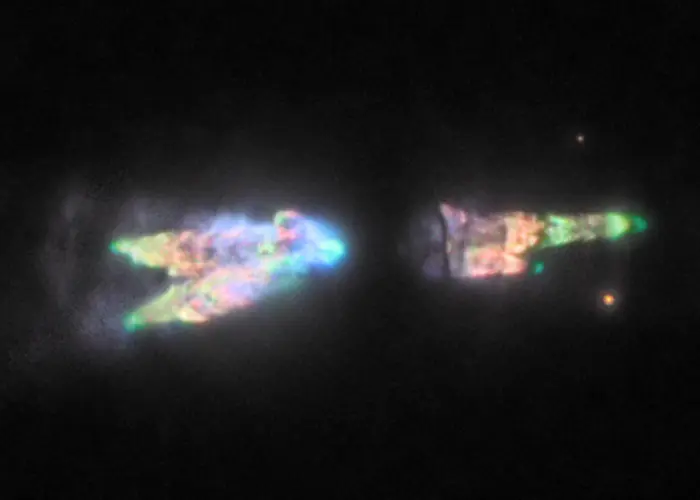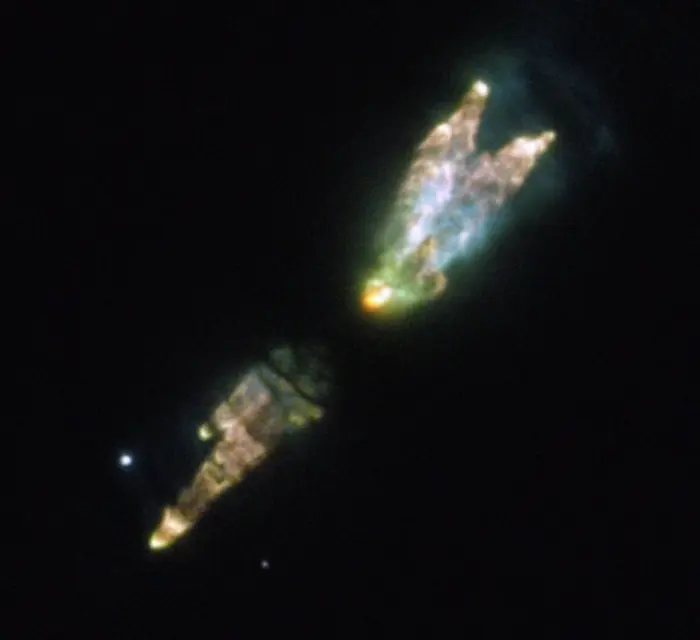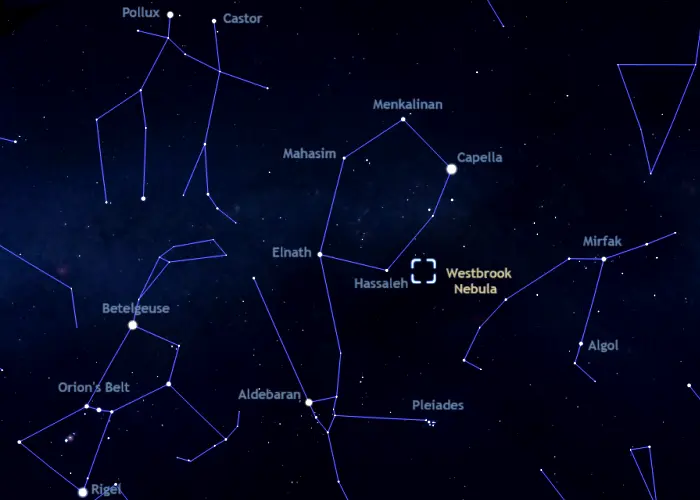The Westbrook Nebula is a bipolar protoplanetary nebula located between 2,900 and 5,500 light-years away in the northern constellation Auriga (the Charioteer). It is classified as a carbon-rich preplanetary nebula that is rapidly evolving into a planetary nebula. The cloud of gas and dust is catalogued as CRL 618, PN G166.4-06.5, and PK 166-06 1.
Protoplanetary nebulae are brief phases in the rapid evolution of evolved stars between the late asymptotic giant branch (AGB) stage and the planetary nebula (PN) stage. These objects are produced by stars with a mass of 1-8 solar masses.
The protoplanetary nebula phase ends when the central star reaches a temperature of around 30,000 K and begins to produce enough ultraviolet radiation to ionize the surrounding nebula. Protoplanetary nebulae are reflection nebulae, while planetary nebulae are emission nebulae. During the protoplanetary phase, the clouds of dust and gas reflect the light of the central star.

Westbrook Nebula (CRL 618), image credit: NASA, ESA, Judy Schmidt (CC BY 2.0)
When these objects become planetary nebulae, the nebular material is ionized by the central star and emits its own light. Because the pre-planetary nebula phase is a relatively brief one in the life cycle of stars, only a few hundred of these objects have been discovered in the Milky Way.
The Westbrook Nebula is produced by an evolved star that has passed through the red giant phase and ceased nuclear processes at its core. Most of the nebula’s mass comes from the material ejected from the central star is an earlier stage of its life cycle. The rest of the material comes from a hotter, faster post-AGB stellar wind with a velocity of more than 190 km/s.
The Westbrook Nebula is composed mainly of molecular gas. It started to form around 200 years ago. The outer part of the nebula consists of gas expelled from the central star when it was on the asymptotic giant branch (AGB). This gas has an expansion velocity of around 30 km/s, much slower than that of the shocked lobes. The ejected gas is interacting with the rapid bipolar outflow from the star.
The nebula’s lobes are composed of shock-excited gas. They are inclined about 24 degrees to our line of sight.
The central star of the Westbrook Nebula has the variable star designation V353 Aurigae. The star is concealed at the nebula’s core. At its brightest, it shines at magnitude 16.5.
The star’s photosphere is hot enough to have started ionizing the surrounding nebula. The ionization is believed to have begun around the year 1971. The nebula is at a more advanced stage than the Egg Nebula, a pre-planetary nebula in the constellation Cygnus, whose central star has not yet started to ionize the expelled material.
V353 Aurigae is a hot star of the spectral type B0V. It has a surface temperature of 27,000 – 32,000 K and a mass of about 0.8 solar masses. The star is 12,200 times more luminous than the Sun. It is expelling material at velocities of up to 200 km/s.
V353 Aurigae is surrounded by a compact HII region. It ionizes the dense molecular torus, making it emit light. The ionized core is rapidly expanding. When most of the nebula has been ionized, it will become a planetary nebula.
The distance of the Westbrook Nebula is uncertain. Studies published in 2008 and 2010 derived distances of 3.572 and 3.613 kiloparsecs (11,650 and 11,784 light-years). More recent studies place the nebula much closer, at 900 parsecs (2,935 ly) and 1.7 kiloparsecs (5,544 ly) away.

Westbrook Nebula, image credit: NASA/ESA/STScI/Hypatia Alexandria (CC BY 2.0)
Facts
The Westbrook Nebula is named after the American astronomer William E. Westbrook, who conducted a survey of four molecular clouds with the 5m Hale telescope in 1975 as part of his doctoral thesis. Westbrook did not discover CRL 618 but was the first to suggest that it may be a nascent planetary nebula. He found an infrared emission located between the two visual nebulosities.
The Westbrook Nebula was discovered by Walker and Price during an infrared sky survey conducted in 1975. One of the nebula’s designations, AFGL 618, stands for Air Force Geophysics Laboratory, a research organization that launched several suborbital rockets equipped with infrared telescopes in the 1970s. The data obtained with these telescopes led to the discovery of hundreds of objects, including the Westbrook Nebula. These objects were challenging or impossible targets for ground-based telescopes.
Observations between 1977 and 1980 found a rise of the radio flux in the nebula, indicating that the ionized central region was expanding. The expansion was attributed to the increasing temperature of the nebula’s central star.
Observations with the Hubble Space Telescope (HST) in the 1990s showed that the morphology of the nebula’s optical emission was dominated by bipolar lobes extending in the east-west direction.
In 2008, observations with the 305m Arecibo Telescope in Puerto Rico revealed 4765 MHz OH emission. This was the first time that excited hydroxyl (OH) masers were detected in a pre-planetary nebula. A 2016 study supported that these masers are short-lived phenomena during the protoplanetary nebula phase. They are typically not found in carbon-rich late-type stellar objects.
The Westbrook Nebula has a similar appearance to several other preplanetary nebulae. These include the Calabash Nebula in the constellation Puppis, the Cotton Candy Nebula in Scorpius, and the Twin Jet Nebula (Minkowski’s Butterfly) in Ophiuchus.

The strange and irregular bundle of jets and clouds in this curious image from the NASA/ESA Hubble Space Telescope is the result of a burst of activity late in the life of a star. As its core runs out of nuclear fuel, the star’s unstable outer layers are puffing out a toxic concoction of gases including carbon monoxide and hydrogen cyanide. The Westbrook Nebula — also known as PK166-06, CRL 618 and AFGL 618 — is a protoplanetary nebula, an opaque, dark and relatively short-lived cloud of gas that is ejected by a star as it runs out of nuclear fuel. As the star hidden deep in the centre of the nebula evolves further it will turn into a hot white dwarf and the gas around it will become a glowing planetary nebula, before eventually dispersing. Because this is a relatively brief stage in the evolution process of stars, only a few hundred protoplanetary nebulae are known in the Milky Way. Protoplanetary nebulae are cool, and so emit little visible light. This makes them very faint, posing challenges to scientists who wish to study them. What this picture shows, therefore, is a composite image representing the different tricks that the astronomers used to unravel what is going on within this strange nebula. The picture includes exposures in visible light which shows light reflected from the cloud of gas, combined with other exposures in the near-infrared part of the spectrum, showing us the dim glow, invisible to human eyes, that is coming from different elements deep in the cloud itself. Image credit: ESA/Hubble & NASA (CC BY 3.0)
Location
The Westbrook Nebula lies in the constellation of Auriga, near the border with Perseus. It can be found about three degrees north of Hassaleh (Iota Aurigae), one of the stars of Auriga’s hexagon, in the direction of Mirfak (Alpha Persei), the brightest star in Perseus.
The Westbrook Nebula is a difficult target in amateur telescopes. It may be spotted in 22-inch and larger telescopes using averted vision in exceptionally good conditions, but even larger telescopes do not reveal much detail of the nebula’s structure.

Location of the Westbrook Nebula in Auriga, image: Stellarium
Westbrook Nebula – CRL 618
| Constellation | Auriga |
| Object type | Protoplanetary nebula |
| Right ascension | 04h 42m 53.6242032600s |
| Declination | +36° 06′ 53.400902220″ |
| Apparent magnitude (J) | 13.510 |
| Apparent magnitude (K) | 8.807 |
| Apparent magnitude (H) | 11.410 |
| Apparent magnitude (B) | 16.54 |
| Apparent size | 0.200 x 0.200 arcminutes |
| Distance | 2,935 light-years (900 parsecs) – 5,544 light-years (1,700 parsecs) |
| Names and designations | Westbrook Nebula, CRL 618, RAFGL 618, PN G166.4-06.5, PK 166-06 1, IRAS 04395+3601, 2MASS J04425364+3606534, V353 Aurigae (V353 Aur), AKARI-IRC-V1 J0442536+360653, AKARI-FIS-V1 J0442534+360706, CGCS 6086, GSC2 N332213229171, TIC 156207408, JCMTSE J044253.8+360655, JCMTSF J044253.8+360655, WISEA J044253.57+360653.3, WISE J044253.57+360653.9, Gaia DR2 174362585452374272, Gaia DR3 174362585455566464 |